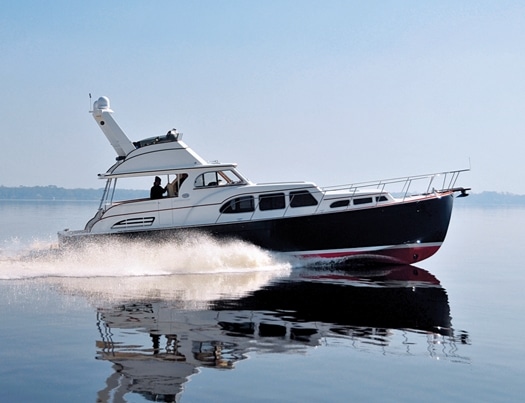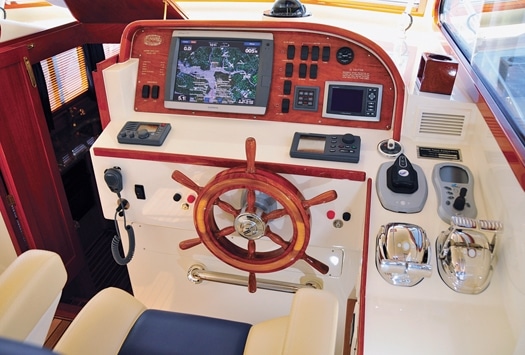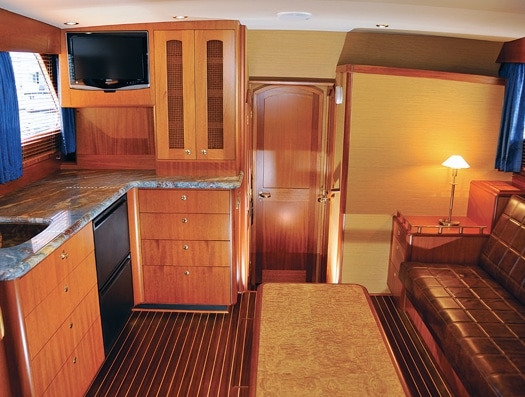
ytgaughuck44525.jpg
The term “custom” as it applies to yachts has become difficult to pin down. The only predictable trend seems to be that, in recent years, custom yachts have grown exponentially in length. That is why the products of small yards like Huckins are so interesting. The boats Huckins builds are not megayacht milestones or speculative ventures. Huckins creations are inspired by yachtsmen who dream of boats and time spent close to the water. Freedom, Huckins’s latest launch, is a great example of how such projects come to life.
The family-owned yard has been building boats since 1928 when Frank Pembroke Huckins figured that folks needed a more efficient way to get about on the water. His patented Quadraconic hull form gained recognition in PT boat design competitions during World War II and later served as a platform for the Huckins yachts that followed in peacetime. The Jacksonville, Florida, yard is now in the capable hands of Huckins’s granddaughter, Cindy Purcell, and her husband, Buddy, and the boats they build still feature the Quadraconic form. Freedom is based on the yard’s Atlantic series circa 1956.
Freedom‘s owner is a knowledgeable yachtsman who grew up boating on the Great Lakes and in South Florida. Together with his wife, he raised a boating family aboard a fleet of runabouts and cruisers. The couple was on a yacht club cruise in the Florida Keys aboard their 40-foot express cruiser when they spotted a Huckins 44 Atlantic. After ogling the boat dockside, they were invited aboard for a closer look. Impressed with the craftsmanship and layout, they visited the yard and met Cindy and Buddy-they were sold. Like all recent Huckins launches, Freedom‘s hull and superstructure were built “one-off” over a male jig. Closed-cell foam coring was secured to a computer- cut jig and the outer fiberglass skin was laminated and faired. The jig was then removed, and the inner skin was laminated. Using disposable jigs to build boats allows Huckins a free hand to meet its clients’ specific requirements. In Freedom‘s case this included an integral transom platform and a flying bridge.

| | |
The Atlantic’s classic styling and all-weather air-conditioned helm station fit her owner’s needs perfectly. When skies are clear, the windshield can be opened with a push of a button, flooding the helm with fresh air. Isinglass curtains can be lifted and the side windows opened. The flying bridge is set back far enough to allow space for hatches in the overhead. Stidd helm and companion seating and matching Garmin plotters allow the mate to navigate and transfer data to the skipper at the wheel. When work is done, a lounge area aft has a settee and a wet bar with an ice maker and an insulated ice chest. A gate leads to the cockpit and a transom door allows access to the integral swim platform.
Below, Freedom is laid out for a cruising couple with an open main cabin and a single stateroom. For the occasional guest, the settee in the main cabin converts to a double berth with the push of a button. A Huckinsdesigned table easily adjusts from cocktail to dining height, and the galley has drawerstyle, under-counter refrigeration. The stateroom has a queen island berth, two hanging lockers, and a vanity. The head compartment is separate from the shower compartment, which makes sense for a cruising boat with a single head. The owners called on interior designer Michael Demanes to work with Huckins on Freedom‘s interior decor. The look, inspired by a classic antique sailing yacht design, features granite, teak and holly soles, and raised-panel, satin-finished mahogany joinery.

| | |
Freedom is fitted with HamiltonJet water jets. In recent years, jets have gained popularity with Huckins’s customers, and while Frank Pembroke Huckins fiddled with them during the war, Purcell and her team have mastered their marriage to his slippery Quadraconic hull. The name Quadraconic related to the four conical projections used to define the hull form. “Granddad considered every aspect of the boat’s design and how it related to performance,” said Purcell. Huckins still keeps a close eye on weight and balance, and – unlike many modern builders-has avoided the temptation of adding too much beam. Freedom‘s 30,000-pound displacement and slim, 13-foot, 9-inch beam suit her form perfectly, and her performance and feel is uniquely Huckins-exhilarating! She rises evenly to plane and has a running angle of 3 to 3.5 degrees. With just 6 degrees of transom deadrise there is no need for tabs, and turns are accomplished with a minimum of banking.
Water jets are most efficient at higher speeds. During our sea trial, I recorded a maximum speed of 30.2 knots at 3350 rpm. At 3000 rpm, I noted a speed of 22 knots and the Cummins electronic gauges indicated a fuel burn of 32.8 gallons per hour. According to Purcell, this is less efficient than similar, conventionally wheeled Huckins models. “We typically see a gallon-per-mile fuel burn on our boats this size.” For Freedom‘s owners, however, the compromise is worthwhile. Her 2-foot, 4-inch draft allows more access to the skinny waters of Florida and the Bahamas. Fussing with engine throttles and water jet buckets while maneuvering dockside can sometimes be a bit confusing. HamiltonJet’s electronic control system minimizes the challenge. Simply move the mouse-like controller in the desired direction and the boat responds to your command. Freedom‘s bow thruster can also be applied, but it is not linked to the system.
Freedom‘s owners have not only fulfilled a dream of building a boat to their own specifications, they have become members of a very special club. Freedom is the 457th Huckins launched since Frank Pembroke Huckins began sawing wood. If you love boats and you are not familiar with Huckins, you should be. If you’re considering a custom yacht and happen to see Freedom dockside, take a few minutes to appreciate her lines. If you’re lucky you might be invited aboard for a closer look!
Huckins Yacht, (904) 389-1125; **www.huckinsyacht.com**









